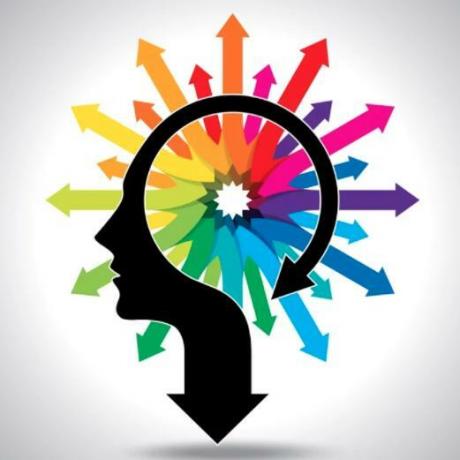
Self-esteem is an element of selfconcept which is defined as the value we place on ourselves. If one of the tasks of development is to build a self-concept, it is essential that that self-concept possesses positive connotations and adjusted to reality. It is very important to work on the foundations of self-esteem and promote a good self-concept in order to develop self-esteem during adolescence and the following stages of our life.
In the following Psychology-Online article, you will find everything you need to know about self-esteem in adolescence: evolution and impact. In addition, we offer you workshops and self-esteem techniques to improve psychological well-being.
Index
- What is self-esteem according to psychology
- The evolution of self-esteem in children
- Children's self-esteem through the school years
- Self-esteem and self-concept in childhood and adolescence
- Self-esteem and adolescence: how to achieve an identity
- Self-esteem in adolescents according to psychology
- Workshops and techniques to raise self-esteem
What is Self-esteem according to psychology.
Does the thought that we are capable of doing something make us feel the same when we have an idea of ourselves as unskilled in a field? It is clear that the knowledge that each subject builds of himself is not only a set of traits or features without repercussion in other areas.
Definition of self-esteem in psychology
We are talking about the self-esteem. We can define self-esteem as the set of judgments we make about who we are. These judgments are associated, in turn, with a set of emotions and feelings. Expressions such as "I am clumsy in social situations" imply an analysis of the subject on several levels:
- Comparison with others who are skilled or considered intelligent or capable.
- They can have associated thoughts about how difficult (if not impossible) to overcome these situations, since On many occasions, these possibilities or aptitudes are understood as characteristics of the subjects and not modifiable.
- These thoughts and judgments carry with them feelings of incompetence, anxiety, etc.
- The individual evaluates, by comparing, what he thinks he is.
But compared to what? William James She points out the foundation of self-esteem in the distinction and comparison between the real I and the ideal I, that is, between what the subject is and what he thinks or feels he should be. In recent years, Higgins establishes a distinction in which she introduces a new element of crucial importance:
- I present or real. They assume the representations that individuals have about what they are, of the attributes that characterize them.
- Ideal me. It is composed of the representations of the set of attributes that the individual would like to possess.
- I should. This I would be made up of the set of representations that the subject considers that he should possess. According to the author, this level of the self would be nourished by the expectations and perceptions of those rights, obligations and responsibilities that individuals believe would be their own.
It seems clear that our belief system about ourselves tends to be compared with another system of representations and beliefs about what we would want or should be. These comparisons will make us realize the existence or not of discrepancies between both systems. Traditionally it has been insisted that discrepancies can be generators of imbalances in the individual. Currently, it is considered that these discrepancies occur naturally and in different magnitudes throughout development.

The evolution of self-esteem in children.
Before talking about self-esteem during adolescence, it is important to know how it develops during the first years of life.
The ability to compare the real self and the ideal self appears relatively early. Before the age of seven, children are able to list a good number of traits that characterize them and what they do well. However, their self-esteem is made up of a set of scattered and unconnected information. Thus, the child can say that he is very brave or that he helps to clean her room without connecting those skills with other more general areas of his performance and, of course, with her personality.
Therefore, Harter points out that preschoolers do not have global self-esteem but a set of first self-esteem. Around two or three years, children perceive themselves as competent in general and expand that perception to all areas: physical and intellectual. This trend is related to the information that caregivers or parents offer them and that, generally, they are flattering and positive, information that changes over the years, becoming more demanding.
Towards the end of the preschool period the child becomes much more sensitive to the evaluations that adults make about his behavior, thoughts and emotions. His feelings for success and the failure they are closely related to the adult's reaction to them. The child learns early that her behaviors are evaluated by others and begins to anticipate the reactions of others to such behaviors. These evaluations they are a fundamental element on which you will build your evaluation.
Therefore, while a young child tends to begin a large number of tasks and persist systematically in them, over the years At the end of the preschool period, children tend, on the contrary, to abandon the task prematurely and make explicit that they will not be able to make. This is the expression of a greater awareness of their capabilities and is related to the importance attributed to the assessment that others will make of the result of their performance.
Likewise, it shows a progressive distinction between skills or abilities and effort, so that, over the years, children become aware that will and work are not always synonymous with success. If this behavior of premature and unjustified abandonment occurs systematically, it can also be a symptom of low self-esteem, insecurity and may be an indication of subjects excessively dependent on the information of the environment.

Children's self-esteem through the school years.
The discrepancies between the real me and the ideal me they tend to increase from age seven and will continue to increase until preadolescence. Throughout the school stage, children have a greater tendency and capacity for self-criticism, which has repercussions that their self-concept is reviewed and, as a consequence, self-esteem is affected.
Between the ages of seven and eleven, a decrease in self-esteem that can be explained taking into account several factors. On the one hand, cognitive development allows subjects new capacities to establish, in a more adjusted way, differences between what they would like to be able to do and be and the abilities and aptitudes they really possess and between facts, beliefs, desires, etc.
Likewise, they have a more realistic vision of their abilities and also of their limitations, that is, less positive but more adjusted than in previous ages. A factor that decisively influences this review of your self-concept and its repercussions on self-esteem is, again, the progress of these ages in the field of social development: their ability to infer what others think, feel or expect regarding their performance and the importance they attach to defrauding or complying with said actions expectations.
The socialization process in which individuals grow immersed supposes the acquisition of an iron set of norms and expectations that end up being assumed by the subjects as their own. By the age of seven or eight, children have already very consistently internalized what others expect of them and, on the other hand, you already know a wide set of norms and rules about very diverse orders.

Self-esteem and self-concept in childhood and adolescence.
For Higgins you are norms and expectations they serve the child as a powerful source of comparison with her real self. That is, these internalizations would be referents, "self-guides" with which the child compares her performance and real competence. With age, these references can change as long as you also develop a feeling of autonomy and independence. Another aspect of essential importance that develops during these years is the formation of a whole constellation of representations, very influenced by variables of the social environment and parenting patterns, about the possibility or not of changing their skills and performances.
For example, a child may think that he is clumsy at mathematics and have the same assumption as intelligence, As a tool for understanding this matter, it is innate or cannot be varied, that is, "it is clumsy" for math. These parenting guidelines to which we alluded are one of the references for the acquisition of good self-esteem. Loving parents who show interest in the various aspects of child and adolescent development and express expectations reasonable and adjusted to the abilities of their children, they tend to generate in them a feeling of positive self-worth and wellness.
These parents and, in the academic field, teachers and professors give children and adolescents a sense of independence and competence. On the contrary, repressive, authoritarian parents, excessively concerned about comparisons with other children, adolescents or models, usually generate in their children a low self-esteem, since they assume the need for external models that control their behavior and that their traits are permanent, that is, with little or no possibility of change.
Parents who use overprotective parenting guidelines can generate the same kinds of self-worth. The peer group is another important reference during these ages, since children tend to systematically compare yourself with others and take into account your opinions and evaluations about them themselves. The consolidation and full performance of his theory of mind, makes children take into consideration any valuation of others since he also performs them on them.
The self-concept generated during these years and their assessment are of great importance for later psychological and emotional development. Many of the visions that one acquires about oneself during childhood, especially during the end of this stage, are difficult to modify in later ages.

Self-esteem and adolescence: how to achieve an identity.
During preadolescence and the first years of adolescence, the subjects experience a slight decrease in their self-esteem that will gradually recover. Various causes have been pointed out as an explanation for this decline. For some authors (Symmons and Blyth), these are found in biological changes and the need for adjustment psychological, and increased awareness of his various aspects of personality (and character contradictory).
Others, on the other hand, point out that the passage from primary school to high school represents a change that originates in many young people feelings of restlessness and disorientation moving from a comfortable, controlled environment in which they were known and in which they had an identity, to one in which increased competitiveness and a more adult relationship with teachers, can make their identity and self-esteem resent.
Another reason given for the decreased self-esteem in adolescence is that the individual adds to his spectrum of expectations and comparisons new areas such as love or job and professional competence. This leads to great disorientation and insecurity. During adolescence, one of the most important and difficult tasks for subjects is to "find themselves".
As Stassen and Thompson point out, they must be built and established as beings independent of the environment, however, they do so from the need to maintain connections with the past. They seek and strive to be autonomous, but at the same time they need to strengthen their belonging to a group by assuming and accepting values, norms and principles of said group.

Self-esteem in adolescents according to psychology.
The construction of a mature identity that is gradually acquired in this stage of life and that will be refined throughout the rest of life is especially relevant. This process and, above all, its resolution has a important role in adolescent self-assessment.
In accordance with Erikson's traditional posturesIn complex societies, adolescents are subjected to very diverse pressures that affect them. They lead to a review of their real self, their self-concept and that promote a review of this and the self-esteem associated with the same.
Erikson's model assumes four moments of quality different as the path to travel in the achievement of an adjusted identity although he points out that said path is not linear nor does it assume that all individuals achieve this identity considered as optimal. In fact, during adult life, identity crises occur that can mean the momentary return of the subject to some unresolved identity phases:
The individuals who settle in the first and second state or moment of identity will turn out to be individuals problematic, in a permanent state of identity crisis and, therefore, susceptible to feeling misfits. The opposite occurs with individuals who are in Commitment Identity phase that tend to evolve to the fourth state, undoubtedly the one that supposes a greater adjustment of the subject to reality. At present the period of adolescence is no longer interpreted in terms of crisis, as defined by Erikson.

Workshops and techniques to raise self-esteem.
One of the challenges that arises from the study of self-esteem in adolescents is the fact of strengthening it. To do this, and now that we have all the necessary information, we are going to offer you some workshops and techniques to raise self-esteem.
The truth is that during this stage, individuals have to integrate in a mature way into new challenges and areas that were previously remote or simply non-existent. An adequate identity, healthy psychologically and that carries with it a high degree of realistic self-esteem, is one that defines an individual committed to values and goals not imposed, but chosen by himself or who seeks them actively.
In both cases, they are individuals who inquire into reality and themselves. Supportive parents and a psychologically welcoming family environment, a place where emotions, ideas and vision of reality can be expressed, with arguments Reasoned and firm, it provides individuals with a source of gratification and security that push them to explore the environment and feel more competent, in general, in their life management.
Activities to raise self-esteem in adolescents
- Do internal dialogue exercisesTaking care of what we say to ourselves and trying to send ourselves positive messages is a very important technique to maintain good self-esteem.
- Turn guilt into responsibilityWhile it is true that we make mistakes throughout our lives, carrying the weight of guilt is not a good thing. Therefore, transform guilt into responsibility to improve.
- Self-care: many times, we forget to provide ourselves with the necessary care and attention and this has a negative impact on our self-esteem. Make time for yourself and to take care of yourself.
- If you want to know more workshops to promote self-esteem, we recommend you read the following article about self-esteem dynamics for adults.
This article is merely informative, in Psychology-Online we do not have the power to make a diagnosis or recommend a treatment. We invite you to go to a psychologist to treat your particular case.
If you want to read more articles similar to Self-esteem in adolescence: evolution and impact, we recommend that you enter our category of Evolutionary Psychology.


